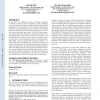Free Online Productivity Tools
i2Speak
i2Symbol
i2OCR
iTex2Img
iWeb2Print
iWeb2Shot
i2Type
iPdf2Split
iPdf2Merge
i2Bopomofo
i2Arabic
i2Style
i2Image
i2PDF
iLatex2Rtf
Sci2ools
CASES
2009
ACM
2009
ACM
Spatial complexity of reversibly computable DAG
In this paper we address the issue of making a program reversible in terms of spatial complexity. Spatial complexity is the amount of memory/register locations required for performing the computation in both forward and backward directions. Spatial complexity has important relationship with the intrinsics power consumption required at run time; this was our primary motivation. But it has also important relationship with the trade off between storing or recomputing reused intermediate values, also known as the rematerialization problem in the context of compiler register allocation, or the checkpointing issue in the general case. We present a lower bound of the spatial complexity of a DAG (directed acyclic graph) with reversible operations, as well as a heuristic aimed at finding the minimum number of registers required for a forward and backward execution of a DAG . We define energetic garbage as the additional number of registers needed for the reversible computation with respect to ...
| Added | 16 Feb 2011 |
| Updated | 16 Feb 2011 |
| Type | Journal |
| Year | 2009 |
| Where | CASES |
| Authors | Mouad Bahi, Christine Eisenbeis |
Comments (0)

